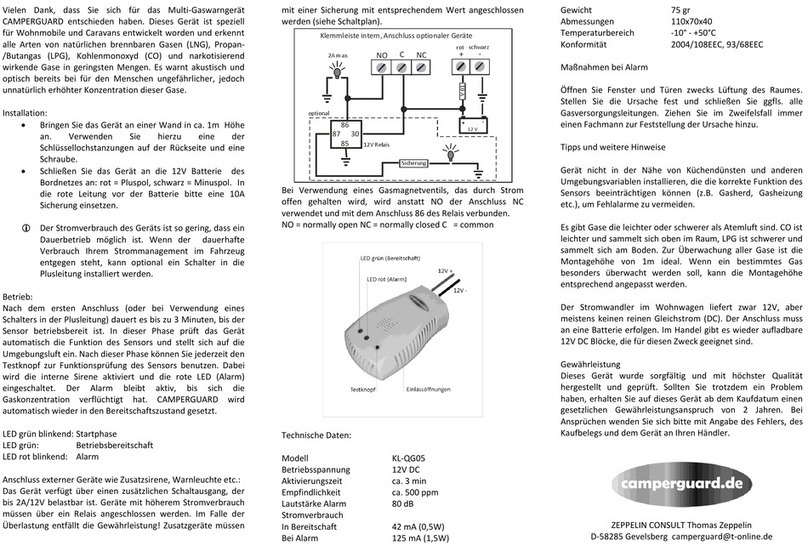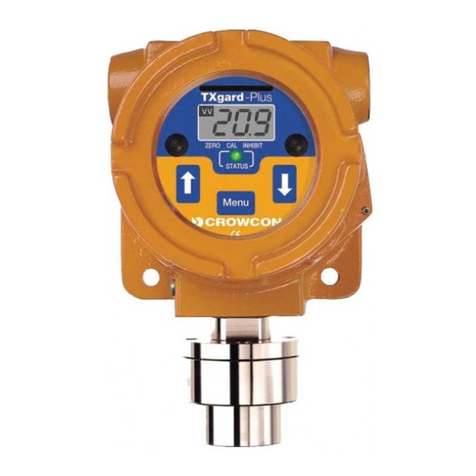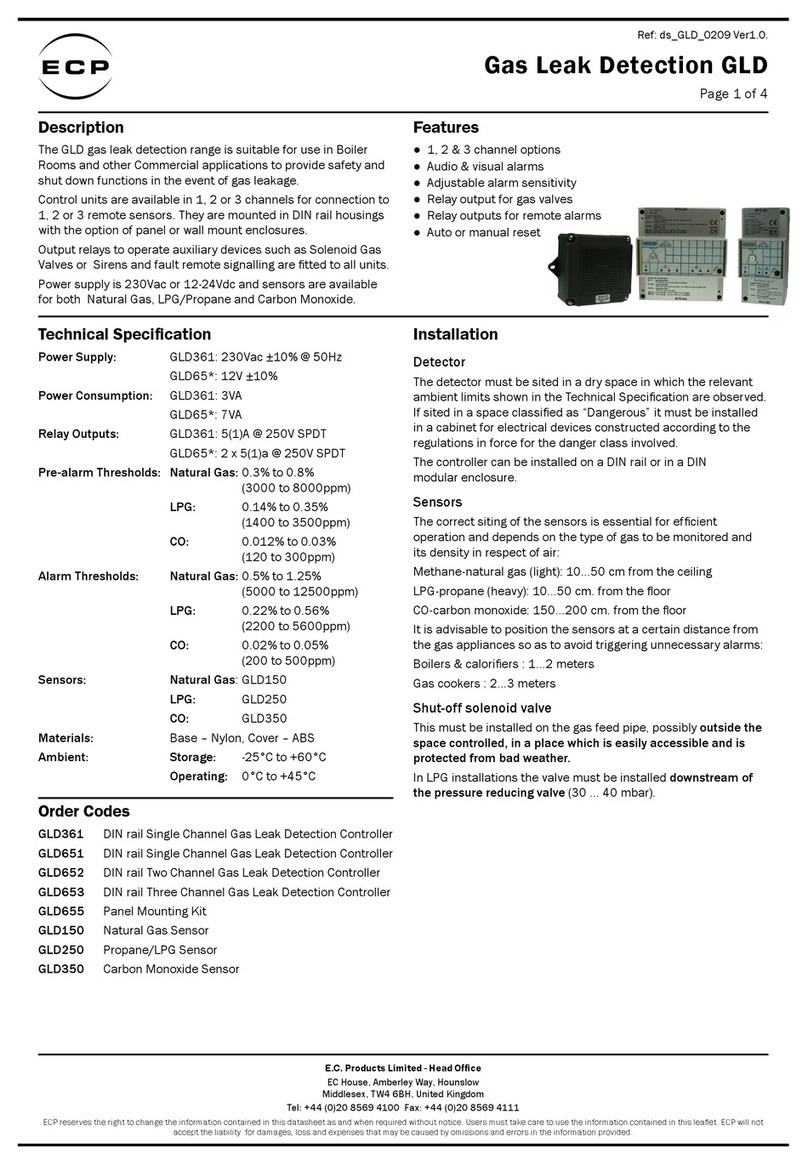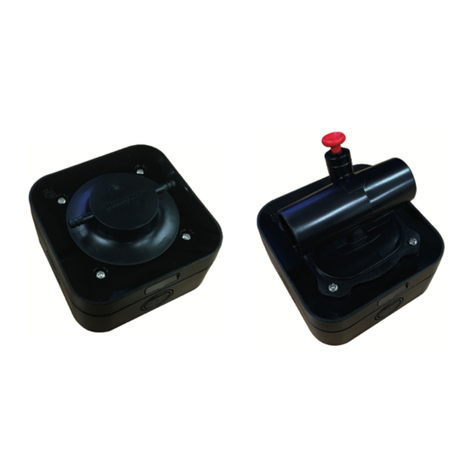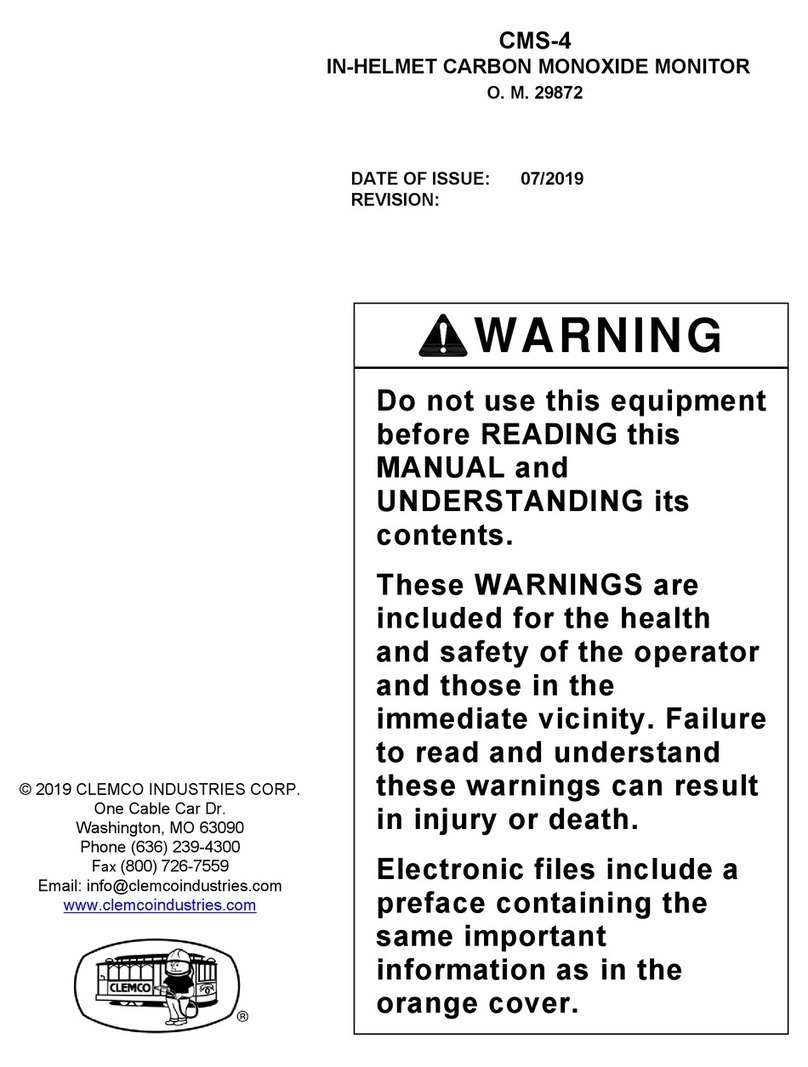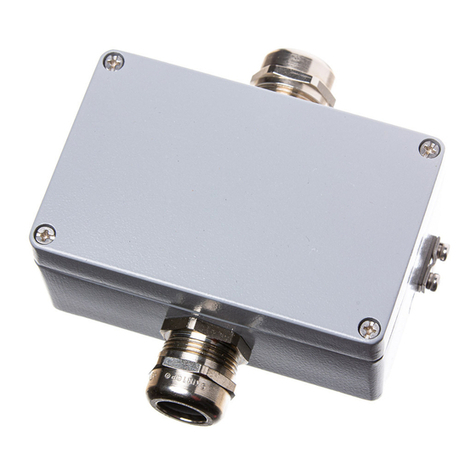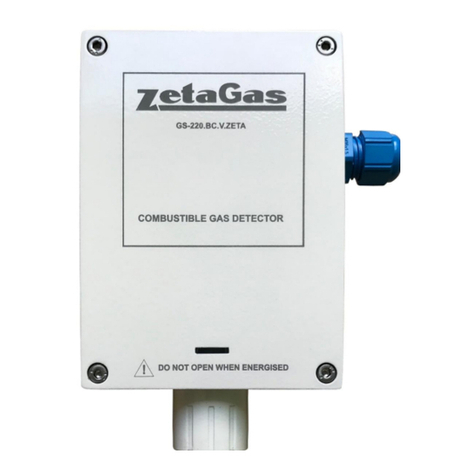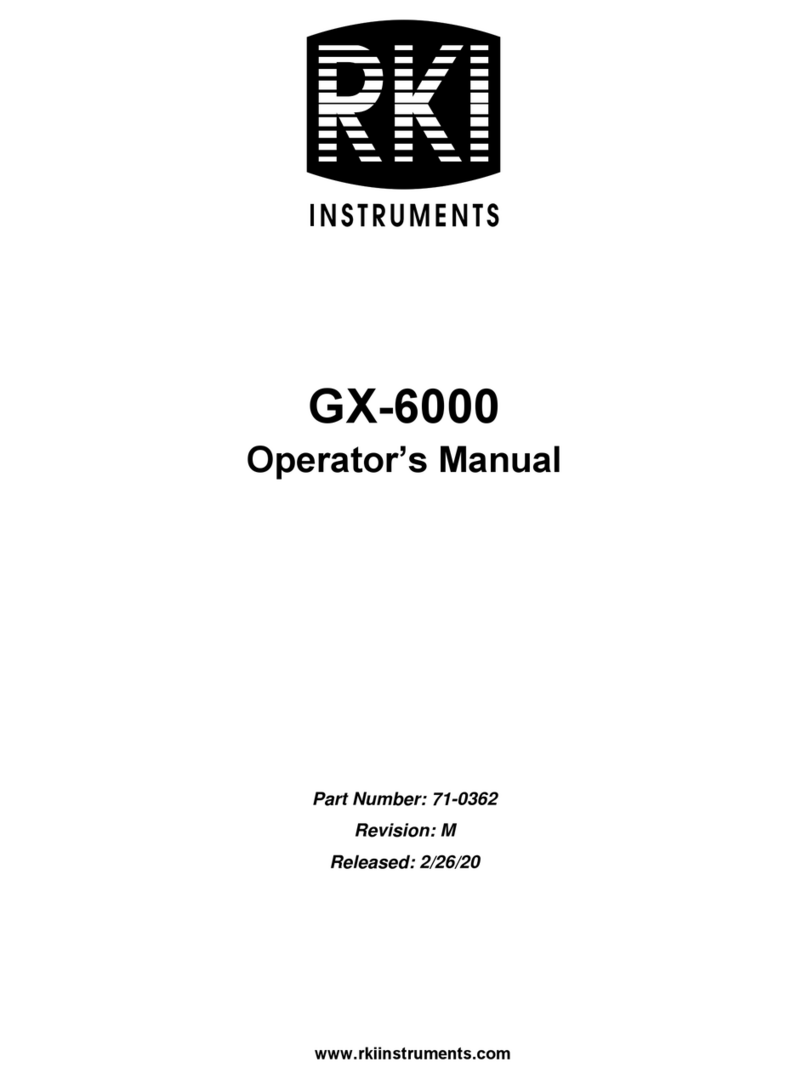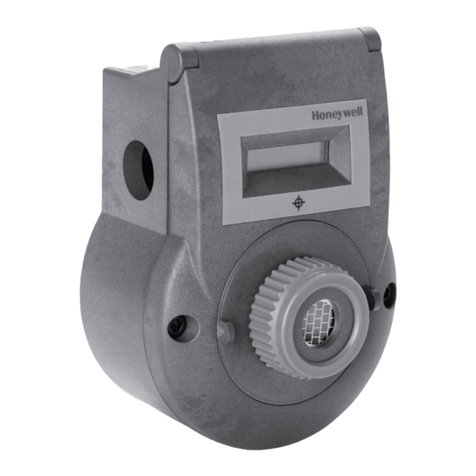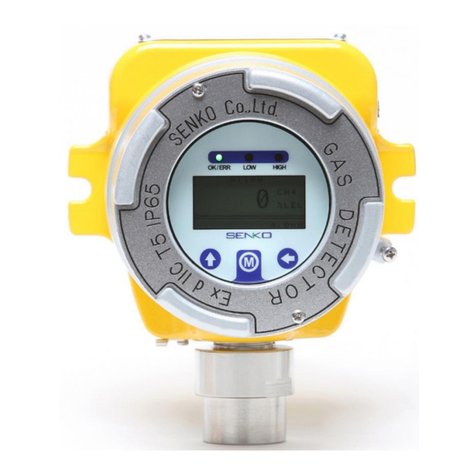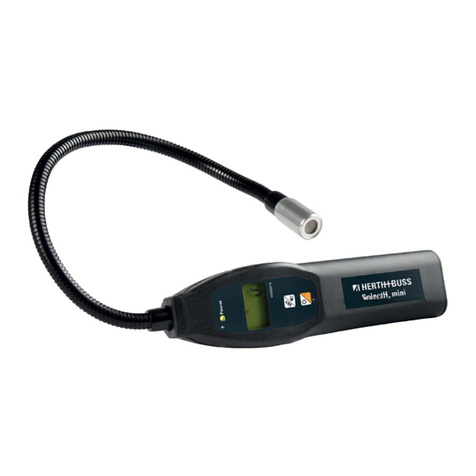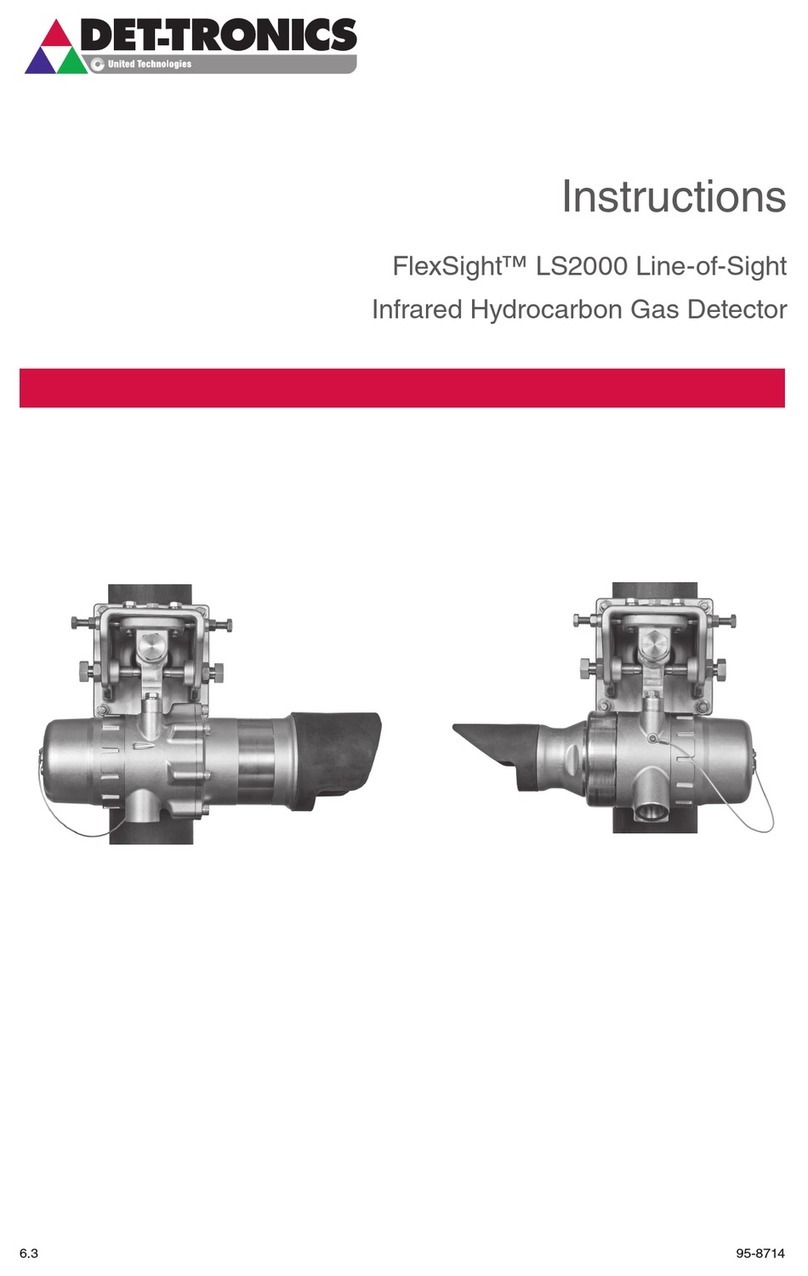FHF YL 6 User manual

Ex-Schallgeber-Blitzleuchten-Kombination YL 6
Ex Sounder / Strobe Light combination YL 6
FHF BA 5872 1
YL 6
• Lautstarker Rundum-Schallgeber
• 2-stufiger Alarm
• 2. Stufe unabhängig wählbar
• Niedrige Montagekosten
• Erfüllt allgemeine Zulassung des Explosionsschutzes
• Niedriger Stromverbrauch
• 2 Kabelöffnungen, Kabeleingang – Kabelausgang
• LM6 Aluminiumgehäuse
• Montageteil aus rostfreiem Stahl
• Borosilikatglasskuppel für Festigkeit und Schutz
• Schutzgitter standardmäßig
• Akustikhaube aus wettersicheren, flammwidrigen ABS
• 5 Farbkalotten aus flammwidrige Polycarbonat,
klar, opal, gelb, rot, orange, blau, grün
• Konstruktion entspricht den europäischen (ATEX)
Anforderungen
• Entspricht den PFEER Vorschriften
• 32 wählbare Töne, die internationale Vorschriften
erfüllen
• Tonauswahl mittels Auswahlschalter
(siehe Tontabelle auf Seite 4)
• Loud non-directional sounder
• 2-stage alarm
• 2nd stage independently chosen
• Low installation costs
• Meets general criteria for approval of
explosion protection
• Low power consumption
• 2 cable openings, cable entry– cable exit
• LM6 aluminium housing
• Stainless steel mounting part
• Borosilicate glass dome for strength and protection
• Default protective grille
• Acoustic hood consisting of weatherproof, flame
retardant ABS
• 5 coloured spheres consisting of flame retardant
polycarbonate, transparent, opal, yellow, red,
orange, blue, green
• Design complies with European (ATEX) demands
• Complies with the PFEER regulations
• 32 tones to choose from, all of which fulfil the
international regulations
• Choice of tone using selector switch
(see tone table on page 4)
Abmessungen / Dimensions
425 mm
16 3/4”
optionale Position / optional position
Alle Abmessungen sind näherungsweise angegeben.
Änderungen bezüglich der Abmessungen und Änderungen
der technischen Leistungsmerkmale aufgrund von Weiter-
entwicklungen und Verbesserungen sind vorbehalten. / All
dimensions are given approximately. As a result of innova-
tions and improvements, dimensions and technical perfor-
mance data are subject to change without further notice.
145 mm
5 3/4”
150 mm
6”
ID: 205818/D8156/R. STAHL/2010-10-22/en-02

Kabelanschluss
Die Kabeleingänge sind mit passen-
den, ATEX zertifizierten, druckfesten
Kabelleitungseinführung für die Gas-
gruppe IIB mit oder ohne ATEX-zerti-
fizierten druckfesten Gewindeadaptern,
zu versehen.
Adapter und Kabel müssen für die
Betriebsbedingungen geeignet sein.
Die Temperatur des Kabeleingangs
kann bis zu 70°C erreichen. Nicht
benutzte Kabeleingänge müssen mit
passenden, ATEX zertifizierten, druck-
festen Verschlussstopfen für die Gas-
gruppe IIB mit oder ohne ATEX zerti-
fizierten, druckfesten Gewindeadaptern,
verschlossen werden (ein ATEX-
zertifizierter Verschlussstopfen ist
standardmäßig vom Hersteller einge-
baut). Geeignete ATEX zertifizierte,
druckfeste Kabelleitungseinführungen,
Gewindeadapter und Verschluss-
stopfen, die als Ausstattung (nicht
Bauteil) mit einer EG-Baumusterprüf-
bescheinigung gemäß Richtlinie
94/9/EG zertifiziert sind, dürfen auch,
wie oben beschrieben, verwendet -
werden. Die Anschlussklemmen können
Kabel mit einem Adernquerschnitt
von 2.5 mm
2
aufnehmen. Die Leiter-
platte kann innerhalb ihrer Führungen
angehoben werden, um einfacher an
die Anschlussklemmen zu gelangen.
Auswahl des Signaltons
–Die Auswahl des Signaltons sollte
in einer zugelassenen Werkstatt
erfolgen.
–Um einen Signalton auszuwählen,
verwenden Sie die Tabelle mit den
Signaltönen und den dazugehörigen
Auswahlschalterstellungen (Seite 4).
–Überprüfen Sie, ob Sie den richti-
gen Signalton für die erste und die
zweite Stufe ausgewählt haben.
–Überprüfen Sie den Signalton
nochmals bevor Sie das Signalge-
rät wieder zusammenbauen.
Zusammenbau des Signalgerätes
–Verbinden Sie das Kabel wieder mit
der Leiterplatte der druckfesten
Einheit und stellen Sie sicher, dass
der Steckverbinder eingerastet ist.
–Vergewissern Sie sich, dass sich die
Leiterplatteneinheit richtig in den
Führungen des Gehäuses befin-
det. Überprüfen Sie, ob sich die
Blitzröhre mittig in der Glaskuppel
befindet und ob sie sichtbar ist.
–Fügen Sie den Schallgeberflansch
wieder mit dem Hauptgehäuse
zusammen, aber achten Sie darauf,
dass das Verbindungskabel weder
zwischen den Gehäuseteilen ge-
klemmt wird noch über der Kante
der Leiterplatteneinheit oder zwi-
schen dem Kopf der Erdungs-
schraube und dem druckfesten
Gehäuse zu liegen kommt.
abdichtendes Teil an das Gerät
angeschlossen werden.
–Geeignete Dichtungsteile sind ein
dichtender Gewindenippel oder eine
abdichtende Kabelleitungseinführung.
Die Wahl der Dichtungsteile hängt
von der zutreffenden Gasgruppe
und der Installationsmethode ab.
–Das Gehäuse des YL 6 hat zwei
Kabeleingänge, von denen einer
oder beide verwendet werden
können. Dies hängt von der Anzahl
der Kabeladern ab, die für die
Konfiguration der Anwendung not-
wendig sind.
–Das Kabel und seine Abdichtung
sollten in einer zugelassenen Werk-
statt angebracht werden; die Art
und Weise, wie man das Kabel
und seine Abdichtung zusammen-
baut, ist im Folgenden beschrieben.
WICHTIG:
–Besondere Vorsicht ist geboten,
wenn Teile, die Bestandteile des
druckfesten Gehäuses sind, ent-
fernt oder ausgetauscht werden.
–Offene Flächen von Verbindungs-
stellen müssen geschützt werden
und dürfen nicht mit Staub oder
Dreck in Kontakt kommen oder
gegen irgendwelche andere Gegen-
stände gestoßen werden.
–Die Endflansche müssen genau
zusammengebaut werden, was auf
keinen Fall mit Gewalt geschehen
darf. Der Flansch darf nicht ge-
hämmert noch mit einem Metall-
gegenstand oder den Schrauben,
die den Flansch festziehen, gehebelt
werden.
–Der Flansch sollte sich problemlos
in das Gehäuse einfügen lassen.
Entfernen Sie die Akustikhaube vom
Schallgeberflansch, indem Sie die drei
Schneidschrauben herausschrauben,
die sich in der Kuppel der Akustik-
haube befinden. Schrauben Sie die
vier Innensechskantschrauben (Innen-
sechskantschraubenschlüssel 4mm
(5/32“)) mit den zwei Unterlegschei-
ben und dem O-Ring aus dem
Flansch. Diese Schrauben sind nicht
voll angezogen, falls die Abdichtung
nicht im Werk erfolgt ist.
WICHTIG:
Höchste Vorsicht ist geboten, wenn
der Schallgeberflansch vom Hauptge-
häuse entfernt wird. Der Hupentrich-
ter darf dabei nicht als Hebel verwen-
det werden.
–Ziehen Sie das Kabel von der Leiter-
platte der druckfesten Einheit ab.
–Die offenen Verbindungsstellen
müssen schmutzfrei und unbe-
schädigt bleiben.
–Legen Sie den Schallgeberflansch
auf ein sauberes Stück Verpak-
kungsmaterial.
2
ANWENDUNG
Der YL 6 ist für den Einsatz in explo-
sionsgefährdeter Umgebung geeignet.
Er ist von der Baseefa Ltd. unter
Anwendung der Normen EN50014
and EN50018 ATEX zertifiziert worden.
Für den Einsatz in explosionsgefähr-
deten Umgebungen, die durch die
Gasgruppe IIB klassifiziert werden,
sind entsprechende Versionen verfüg-
bar. Ein Signalgerät, das für eine be-
stimmte Gasgruppe zugelassen ist,
darf auch in Umgebungen mit einer
weniger gefährlichen Gasgruppe be-
trieben werden, das heißt IIB Geräte
sind auch für die Gasgruppe IIA ge-
eignet.
Der YL 6 ist für den Betrieb im Freien
geeignet. Er erfüllt die Anforderung
der Norm EN 60529 für die Schutz-
klasse IP66.
MONTAGE
Befestigungsteil liegt bei. Bohrloch-
durchmesser 9 mm. Abstand der
Bohrlöcher 75 mm.
ALLGEMEINES
Der YL 6 muss gemäß dieser Be-
triebsanleitung installiert werden. Der
YL 6 muss außerdem entsprechend
den gewerblichen und behördlichen
Anforderungen installiert werden.
VORBEREITUNG
Stellen Sie sicher, dass die Stromver-
sorgung abgeschaltet ist, bevor Sie
mit der Installation beginnen.
A. Überprüfen Sie, ob Sie das richtige
Signalgerät haben, dass die System-
anforderungen erfüllt:
–Gasgruppe und Temperatur
–Betriebsspannung
–ausgewählter Signalton
–richtige Farbe der Blitzlichtkalotte
–geeigneter Befestigungsort
–Kabelanschluss und Installations-
methode
B. Befestigungsort
–Wählen Sie einen geeigneten Befe-
stigungsort für das Gerät in Hin-
blick auf den Bereich, der mit dem
Signalton und dem Blitzlicht abge-
deckt werden soll.
–Im Montagebereich sollte die Ober-
fläche eben sein und der Untergrund
vom Material her geeignet sein,
das Gewicht des Gerätes zu tragen.
–Das Gerät muss mit der Akustik-
haube nach oben montiert werden.
–Das Gerät sollte nicht im Bereich
direkter Sonneneinstrahlung mon-
tiert werden.
–In Ausnahmefällen kann der YL 6
horizontal angebracht werden,
nicht zulässig ist die Montage mit
der Akustikhaube nach unten.
–Das Kabel muss über ein direkt an
den Kabeleingängen befindliches,
ID: 205818/D8156/R. STAHL/2010-10-22/en-02

–Prüfen Sie, ob der O-Ring richtig in
die Gehäusenut eingelegt ist
–Seien Sie vorsichtig, wenn Sie den
Flansch einbauen. Dieser muss
gerade in das Hauptgehäuse ein-
gefügt werden. Gewalt darf dabei
nicht angewendet werden. Der
Flansch sollte sich problemlos in
das Gehäuse einfügen lassen
–Die Schrauben dürfen nicht dazu
verwendet werden, den Flansch
an das Gehäuse zu ziehen.
–Jede Innensechskantschraube soll-
te mit einer Sicherungsscheibe,
einer Unterlegscheibe und einem
O-Ring eingebaut werden. Der O-
Ring muss sich am Boden der
Senkung befinden. Ziehen Sie die
Innensechskantschrauben fest an.
Anmerkung:
–Wenn der YL 6 bereits in Betrieb
war und/oder die Innensechskant-
schrauben im Flansch schon ein-
mal festgezogen wurden, dann ist
es ratsam, die O-Ringe auszu-
wechseln (Teilenummer GR0192)
bevor die Schrauben wieder fest-
gezogen werden.
–Befestigen Sie die Akustikhaube
wieder an den Hupentrichter unter
Verwendung der drei Schneid-
schrauben.
WECHSEL DER KALOTTE
–Wenn die Farbe der Blitzlichtkalot-
te gewechselt werden soll, dann
ist es nicht notwendig das Gerät
von seinem Montageort zu entfer-
nen oder das druckfeste Gehäuse
zu öffnen.
–Entfernen Sie das Schutzgitter.
Drehen Sie die beiden Schrauben,
die die Kalotte mit dem Ring des
Blitzlichtflansches verbinden, her-
aus und entfernen Sie die Kalotte.
–Stellen Sie sicher, dass der O-Ring
richtig in die Nut des Flansches
eingelegt ist.
–Befestigen Sie die neue Kalotte
über dem O-Ring mit neuen
Schrauben und Unterlegscheiben,
die sich in der Ersatzteilpackung
befinden.
–Bringen Sie das Schutzgitter wie-
der an.
INSTALLATION
–Stellen Sie sicher, dass die Ober-
fläche des gewählten Montageortes
eben und auch in der Lage ist, das
Gewicht des Geräts zu tragen.
–Entnehmen Sie das Montageteil,
die Befestigungsschrauben und
die Unterlegscheiben dem Beutel,
der sich in der Verpackung befindet.
Befestigen Sie das Montageteil mit
den zwei Sechskantschrauben
(M6x16mm), den Sicherungs- und
Unterlegscheiben an das Gehäuse
des YL 6.
–Überprüfen Sie, ob das Montageteil
fest mit dem Gehäuse verbunden
ist. Die Befestigung des Signalge-
rätes am Montageort erfolgt über
die zwei Löcher ∆9 mm (0.35“) mit
75 mm (2.95“) Mittenabstand.
–Für die Befestigung sollten geeig-
nete Schrauben (nicht im Lieferum-
fang enthalten) verwendet werden.
ZUSAMMENSCHALTUNG
VON SIGNALGERÄTEN
Die Signalgeräte können in Parallel-
schaltung miteinander verbunden
werden. Bis zu zehn Signalgeräte
können an einer gemeinsamen Ver-
sorgung zu einer Systemlinie zusam-
mengeschaltet werden. Die beiden
Gruppen von Anschlussklemmen
sollten so verwendet werden, dass
sie eine Eingangs- und Ausgangsver-
bindung bereitstellen.
3
Technische Daten
IP66
Blitz 5 Joules
Blitzfolgefrequenz 1 Hz
Schallgeber-Lautstärke 110 dB @ 1 m
Betriebsspannung 230 Vac oder 24 Vdc
Stromaufnahme 230 Vac 100 mA
Betriebstemperatur -35°C bis +60°C für Gasgruppe IIB
Normen und Bescheinigungen
Europäische Standards EN 50014:1997 + Anhang 1 & 2; EN 50018:2000: EN 50281-1-1:1998
Baseefa 06 ATEX 0334X
ATEX Richtlinie 94/9/EC
Systemoptionen
Versorgungsspannungen 230 Vac oder 24 Vdc
Signaltonauswahl 32 (siehe Tabelle)
Signalstufen eine oder zwei Stufen
Blitzlicht Getrennte Phasen-Anschlussklemmen für eine unabhängige Stromversorgung
Anmerkung: Der Nullleiter ist gemeinsam
Mit L1 and L2 gekennzeichnete Phasen-Anschlussklemmen sollten mit einem
geeigneten Kabel auf der Anschlussleiterplatte verbunden werden.
Kalottenfarben klar, rot, blau, grün, gelb
Kabeladern Die Anzahl der Kabeladern hängt von den Systemanforderungen ab.
Erdung
Das Gerät muss mit einer guten Erdung verbunden sein. Erdungsanschlüsse befinden sich innerhalb und außerhalb
des Gehäuses. Diese Erdungsanschlüsse sind mit dem Erdungssymbol kenntlich gemacht. Der innere Erdungsan-
schluss muss verwendet werden. Der äußere Anschluss ist eine zusätzliche Verbindungsstelle und wird da verwendet,
wo örtliche Regeln oder Behörden dies erlauben oder vorschreiben.
ID: 205818/D8156/R. STAHL/2010-10-22/en-02

Cable connection
The cable entries should be equipped
with fitting, ATEX-certified, flame-
proof cable glands for gas group
IIB, with or without ATEX-certified,
flameproof thread adapters.
The adapter and the cable must
comply with the operating con-
ditions.
The temperature of the cable entry
may reach up to 70°C. Unused
cable entries must be closed using
fitting, ATEX-certified, flameproof
blind plugs for gas group IIB with
or without ATEX-certified, flame-
proof thread adapters (per default,
the manufacturer has included one
ATEX-certified blind plug).
Fitting ATEX-certified, flameproof
cable glands, thread adapters and
blind plugs, which are certified as
equipment (not as components) by
means of an EC type examination
certificate in accordance with direc-
tive 94/9/EC, may also be used, as
described above. The terminals
can accommodate cables with a
conductor cross-section of 2.5 mm2.
The circuit board can be lifted
slightly within its guides, in order to
access the terminals more easily.
Selecting the signalling tone
–The signalling tone should be
selected in an approved work-
shop.
–In order to select a signalling
tone, use the table with the
signalling tones and the corre-
sponding selector switch settings
(page 4).
–Check to see if you have selec-
ted the correct signalling tone for
the first and the second stage.
–Check the signalling tone several
times before re-assembling the
signalling device.
Assembling the signalling device
–Connect the cable with the
circuit board of the flameproof
unit, and make sure the connector
has engaged.
–Make sure the circuit board unit
is correctly situated in the house
guidings. Check to see if the flash
tube is situated in the centre of
the glass dome and if it is visible.
–Join the sounder flange and the
main housing again, but make
sure the connecting cable does
not get pinched between the
housing parts, and does not
come to rest over the edge of
the circuit board unit or between
the head of the earth screw and
the flameproof housing.
the device with the acoustic
hood directed downwards.
–The cable must be connected to
the device through a sealing part
situated directly at the cable entry.
–A suitable sealing part would be
a sealing threaded gland or a
sealing cable gland.
The choice of sealing parts
depends on the gas group in
question and of the method of
installation.
–The YL 6 housing is equipped
with two cable entries, of which
one or both may be used. This
depends on the number of cable
conductors necessary for the
configuration of the application.
–The cable and its seal should be
mounted in an approved work-
shop; how to assemble the
cable and its seal is described
below.
IMPORTANT:
–Please be especially cautious
when removing or replacing
parts belonging to the flame-
proof housing.
–Open surfaces of connections
must be protected and should
not make contact with dust or
dirt, or bump against any other
items.
–The end flange must be assem-
bled with great precision, and by
no means by use of excessive
force. The flange must not be
hammered or levered using a
metallic item or the fastening
screws of the flange.
–The flange should fit effortlessly
into the housing.
Remove the acoustic hood from
the sounder flange by removing the
three self-tapping screws situated
in the dome of the acoustic hood.
Unscrew the four hexagon socket
screws (hexagon socket screw
wrench 4 mm (5/32“)) with the two
washers and the O-ring from the
flange. These screws are not com-
pletely tightened, if the sealing has
not been undertaken at the factory.
IMPORTANT:
Please proceed with extreme cau-
tion when removing the sounder
flange from the main housing. The
hooter horn must not be used as a
lever.
–Pull the cable off of the circuit
board of the flameproof unit.
–The exposed connections must
stay clean and undamaged.
–
Place the sounder flange on a
clean piece of packaging material.
4
OPERATION
The YL 6 is intended for use in
hazardous areas.
It has been certified by Baseefa
Ltd. in accordance with the stan-
dards EN50014 and EN50018
ATEX.
For use in hazardous areas classi-
fied by gas group IIB, correspon-
ding versions are available.
A signalling device, which has been
approved for a certain gas group,
may also be used in areas subjec-
ted to a less dangerous gas group,
i.e. IIB devices may also be used
for gas group IIA.
The YL 6 is intended for outdoor
use. It fulfils the demands of
standard EN 60529 for the IP66
degree of protection.
INSTALLATION
Fastener is included. Bore diameter
9 mm. Distance between bore-
holes 75 mm.
GENERAL
The YL 6 must be installed in
accordance with this manual. The
YL 6 must also be installed in
compliance with the relevant pro-
fessional and legal demands.
PREPARATIONS
Make sure the power supply has
been switched off prior to installa-
tion.
A.
Check that you have the correct
signalling device, i.e. the one
that meets the system require-
ments:
–Gas group and temperature
–Operating voltage
–Selected signalling tone
–Correct colour of the strobe
light sphere
–Suitable fixing location
–Cable connection and
method of installation
B.
Fixing location
–Choose a suitable fixing location
for the device, considering the
area to be covered by the sig-
nalling tone and the strobe light.
–The surface of the installation
area should be level and consist
of a material that is able to carry
the load of the device.
–The device must be mounted
with the acoustic hood on top.
–The device should not be instal-
led in an area where it will be
exposed to direct sunlight.
–In exceptional cases the YL 6
may be placed horizontally. Not
allowed, however, is installing
ID: 205818/D8156/R. STAHL/2010-10-22/en-02

–Check to see if the O-ring is cor-
rectly inserted into the housing
groove.
–Be careful when mounting the
flange. It has to be inserted
straight into the main housing.
Do not use force during this pro-
cedure. The flange should fit eff-
ortlessly into the housing.
–The screws may not be used to
pull the flange towards the hou-
sing.
–Each hexagon socket screw
should be mounted with a lock
washer, a flat washer and an O-
ring. The O-ring must be situa-
ted at the bottom of the groove.
Tighten the hexagon socket
screw well.
Note:
–If the YL 6 has already been in
operation and/or the hexagon
socket screws in the flange have
already been tightened, it is
recommendable to replace the
O-rings (P/N GR0192) before
the screws are tightened again.
–Re-fasten the acoustic hood to
the hooter horn, using the three
self-tapping screws.
REPLACING THE SPHERE
–If you want to change the colour
of the strobe light sphere, you
do not have to remove the device
from its place of installation or to
open the flameproof housing.
–Remove the protective grille.
Unscrew completely the two
screws connecting the sphere
and the ring of the strobe light
flange, and remove the sphere.
–Make sure the O-ring has been
placed correctly into the groove
of the flange.
–Fasten the new sphere over the
O-ring using new screws and
washers, which you will find in
the replacement parts package.
–Put the protective grille back on.
INSTALLATION
–Make sure the surface of the
chosen place of installation is
even and also capable of carry-
ing the weight of the device.
–Remove the mounting part, the
fastening screws and the flat
washers from the bag, which is
contained in the package.
Using the two hexagon screws
(M6x16mm), the locking and flat
washers, fasten the mounting
part to the housing of the YL 6.
–Check to see if the mounting
part has been joined tightly with
the housing. The signalling device
is fixed to the place of installa-
tion using two Ä9 mm (0.35“)
holes with a dual spacing of 75
mm (2.95“).
–For fixation, use suitable screws
(not included).
INTERCONNECTING
SIGNALLING DEVICES
The signalling devices may be con-
nected in parallel with each other.
Up to ten signalling devices may be
interconnected to a system line,
using a common power supply.
Both groups of terminals should be
used in such a way as to enable an
input and an output connection.
5
Technical Specifications
IP66
Flash 5 Joule
Flash sequence frequency 1 Hz
Sounder sound level 110 dB at 1 m
Operating voltage 230 Vac or 24 Vdc
Current consumption 230 Vac 100 mA
Operating temperature -35°C to +60°C for gas group IIB
Standards and certificates
European standards EN 50014:1997 + Appendices 1 & 2; EN 50018:2000: EN 50281-1-1:1998
Baseefa 06 ATEX 0334X, ATEX Directive 94/9/EC
System options
Supply voltages 230 Vac or 24 Vdc
Selection of signalling tones 32 (see table)
Signalling stages One or two stages
Strobe light Separate phase-terminals for independent power supply
Note: The neutral conductor is common
Phase terminals labelled L1 and L2 should be connected with a suitable
cable on the connection circuit board.
Sphere colours Transparent, red, blue, green, yellow
Cable conductors The number of cable conductors depends on the system requirements.
Earth
The device must be connected with a good earth connection. Earth connections are situated within the housing
and on the outside of it. These earth connections are labelled with the earth symbol. The inner earth connection
must be used. The outer connection is an additional connection and is used where local rules or authorities allow
or demand it.
ID: 205818/D8156/R. STAHL/2010-10-22/en-02

Weitere Informationen
–Gewicht 5,6 kg
–Alle Metallgussteile sind aus LM6 Aluminiumle-
gierung, korrosionsbeständig, eloxiert und die
Außenflächen sind mit einer Polyesterfarbe über-
zogen.
–Die Blitzlichtkuppel ist aus durchsichtigem
Borosilikatglass.
–Die Gehäuseteile für die Schallabstrahlung sind
aus flammhemmenden ABS.
–Die farbige Kalotte ist aus flammhemmenden
Polycarbonat.
–Alle äußeren Befestigungselemente sind aus
rostfreiem Stahl.
–Der Schallgeber hat 32 Signaltöne. Von den 32
Signaltönen kann jeder für die erste, als auch für
die zweite Stufe ausgewählt werden.
–Lautstärke und Stromverbrauch sind vom ausge-
wählten Signalton abhängig.
Die typische Lautstärke ist 110 dB(A) in 1 m Ent-
fernung. Die typische Stromaufnahme für den
Schallgeber ist 110 mA bei 115 Vac und 55 mA
bei 230 Vac, wiederum abhängig vom gewählten
Signalton. Diese Werte treffen für die Gasgruppe
IIB zu. Für die Gasgruppe IIB+H2 ist die Laut-
stärke um ca. 3 dB reduziert.
–Das Blitzlicht hat eine Blitzfrequenz von 1 Hz,
d.h. ein Blitz pro Sekunde. Die Blitzenergie
beträgt 5 Joule mit einem typischen Stromver-
brauch von 90 mA bei 115 Vac und 45 mA bei
230 Vac.
Die von UKOOA empfohlenen PFEER Signaltöne sind:
Allgemeiner Alarm Signalton 15 Unterbrochener Ton 1000 Hz
PAPA Signalton 31 Fallender Ton 1200-500 Hz
Giftgas Signalton 11 Dauerton 1000 Hz
Signalton Frequenz Wieder- Auswahl- Spez.
holrate schalter Anwendungen
1 2 3 4 5
SW1, SW2
1 Wechselton 800-1000 0.5 1 1 1 1 1 Feueralarm
2 Wechselton 2500-3100 0.5 0 1 1 1 1 Sicherheitsalarm
3 Wechselton, schnell 800-1000 0.25 1 0 1 1 1 Erhöhte Dringlichkeit
4 Wechselton, schnell 2500-3100 0.25 0 0 1 1 1 Abschreckung
5 Wechselton 440-554 0.4/0.1 1 1 0 1 1 Evakuierungsalarm, (F)
6 Wechselton 430-470 1.0 0 1 0 1 1
7 Wechselton, sehr schnell 800-1000 0.13 1 0 0 1 1
8 Wechselton, sehr schnell 2500-3200 0.07 0 0 0 1 1
9 Wechselton 440-554 2.0 1 1 1 0 1 Räumung (S)
10 Dauerton 700 - 0 1 1 0 1 Entwarnung (S)
11 Dauerton 1000 - 1 0 1 0 1
12 Dauerton 1000 - 0 0 1 0 1
13 Dauerton 2300 - 1 1 0 0 1
14 Dauerton 440 - 0 1 0 0 1
15 Unterbrochener Ton 1000 2.0 1 0 0 0 1
16 Unterbrochener Ton 420 1.25 0 0 0 0 1
17 Unterbrochener Ton 1000 0.5 1 1 1 1 0
18 Unterbrochener Ton 2500 0.25 0 1 1 1 0
19 Unterbrochener Ton 2500 0.5 1 0 1 1 0
20 Unterbrochener Ton 700 6/12 0 0 1 1 0 Wichtige Nachricht (S)
21 Unterbrochener Ton 1000 1.0 1 1 0 1 0
22 Unterbrochener Ton 700 4.0 0 1 0 1 0 Fliegeralarm (S)
23 Unterbrochener Ton 700 0.25 1 0 0 1 0 Lokale Warnung (S)
24 Unterbrochener Ton 720 0.7/0.3 0 0 0 1 0 Industriealarm (D)
25 Unt.Ton, schnell, anst. Lautst. 1400 0.25 1 1 1 0 0
26 Schnelle Sirene 250-1200 0.085 0 1 1 0 0
27 Anst., konst., fallend 1000 10/40/10 1 0 1 0 0 Industriealarm (D)
28 ISO 8201 Evakuierung 800-1000 as std 0 0 1 0 0 Intern. Evakuierungsalarm
29 Schnell ansteig. Ton 500-1000 0.15 1 1 0 0 0
30 Langsam ansteig. Ton 500-1200 4.5 0 1 0 0 0 Evakuierungsalarm (NL)
31 Fallender Ton 1200-500 1 1 0 0 0 0 Evakuierungsalarm, (D)
32 Sirene 500-1200 3.0 0 0 0 0 0
Signaltöne
Schalterstellungen:
1 = EIN / 0 = AUS D = Deutschland
F = Frankreich NL = Niederlande
S = Schweden
6
ID: 205818/D8156/R. STAHL/2010-10-22/en-02

Further information
–Weight 5.6 kg
–All die-cast metal parts consist of an LM6 alumi-
nium alloy and are corrosion proof and anodized,
and the outer surfaces are covered in polyester
paint.
–The strobe light dome is made of transparent
borosilicate glass.
–The housing parts for the sound reflection are
made of flame retardant ABS.
–The coloured sphere is made of flame retardant
polycarbonate.
–All outer fasteners are made of stainless steel.
–The sounder has 32 signalling tones. Of the 32
signalling tones, each one can be selected for the
first and also for the second stage.
–Sound level and power consumption depend on
the selected signalling tone.
The typical sound level is 110 dB(A) at a distance
of 1 m.
The typical power consumption of the sounder is
110 mA at 115 Vac and 55 mA at 230 Vac, again
depending on the selected signalling tone. These
values are valid for gas group IIB. For gas group
IIB+H2, the sound level is reduced by approx.
3 dB.
–The strobe light has a flash frequency of 1 Hz, i.e.
a flash per second. The flash energy amounts to 5
Joule with a typical power consumption of 90 mA
at 115 Vac and 45 mA at 230 Vac.
The PFEER signalling tones recommended by the UKOOA are:
General alarm Signalling tone 15 Intermittent tone 1000 Hz
PAPA Signalling tone 31 Falling tone 1200-500 Hz
Toxic gas Signalling tone 11 Continuous 1000 Hz
Signalling tone Frequency Repeating Selector Special
rate switch applications
1 2 3 4 5
SW1, SW2
1
Alternating tone
800-1000 0.5 1 1 1 1 1
Fire alarm
2
Alternating tone
2500-3100 0.5 0 1 1 1 1
Security alarm
3
Alternating tone, quick
800-1000 0.25 1 0 1 1 1
Increased urgency
4
Alternating tone, quick
2500-3100 0.25 0 0 1 1 1
Deterrence
5
Alternating tone
440-554 0.4/0.1 1 1 0 1 1
Evacuation alarm, (F)
6
Alternating tone
430-470 1.0 0 1 0 1 1
7
Alternating tone, very quick
800-1000 0.13 1 0 0 1 1
8
Alternating tone, very quick
2500-3200 0.07 0 0 0 1 1
9
Alternating tone
440-554 2.0 1 1 1 0 1
Evacuation (S)
10
Continuous tone
700 - 0 1 1 0 1
All-clear (S)
11
Continuous tone
1000 - 1 0 1 0 1
12
Continuous tone
1000 - 0 0 1 0 1
13
Continuous tone
2300 - 1 1 0 0 1
14
Continuous tone
440 - 0 1 0 0 1
15
Intermittent tone
1000 2.0 1 0 0 0 1
16
Intermittent tone
420 1.25 0 0 0 0 1
17
Intermittent tone
1000 0.5 1 1 1 1 0
18
Intermittent tone
2500 0.25 0 1 1 1 0
19
Intermittent tone
2500 0.5 1 0 1 1 0
20
Intermittent tone
700 6/12 0 0 1 1 0
Important message (S)
21
Intermittent tone
1000 1.0 1 1 0 1 0
22
Intermittent tone
700 4.0 0 1 0 1 0
Air-raid warning (S)
23
Intermittent tone
700 0.25 1 0 0 1 0
Local warning (S)
24
Intermittent tone
720 0.7/0.3 0 0 0 1 0
Industrial alarm (D)
25
Intermittent tone, quick
1400 0.25 1 1 1 0 0 I
ncreasing sound stage
26
Rapid siren
250-1200 0.085 0 1 1 0 0
27
Increasing, constant, falling
1000 10/40/10 1 0 1 0 0
Industrial alarm (D)
28
ISO 8201 Evacuation
800-1000 as std 0 0 1 0 0
Intern. evacuation alarm
29
Rapidly increasing tone
500-1000 0.15 1 1 0 0 0
30
Slowly increasing tone
0 1 0 0 0
Evacuation alarm (NL)
31
Falling tone
1200-500 1 1 0 0 0 0
Evacuation alarm, (D)
32
Siren
500-1200 3.0 0 0 0 0 0
Signalling tones
Switch positions:
1 = ON / 0 = OFF D = Germany
F = France NL = Netherlands
S = Sweden
7
ID: 205818/D8156/R. STAHL/2010-10-22/en-02

Auswahlschalter zur Signaltonauswahl
Blitzlicht und Schallgeber (nur eine Stufe)
Systemverkabelung für Blitzlicht und Schallgeber (inklusive 2. Stufe)
ANSCHLUSS DES YL 6 UND SIGNALTONWAHL
Systemsteuerung
Blitzlicht
Schallgeber
Systemsteuerung
Blitzlicht
Schallgeber
8
ID: 205818/D8156/R. STAHL/2010-10-22/en-02

9
Selector switch for selection of signalling tone
Strobe light and sounder (one stage only)
System wiring for strobe light and sounder (including 2nd stage)
CONNECTION OF YL 6 AND SELECTION OF SIGNALLING TONE
System control
Strobe light
Sounder
System control
Strobe light
Sounder
ID: 205818/D8156/R. STAHL/2010-10-22/en-02

10
ID: 205818/D8156/R. STAHL/2010-10-22/en-02

11
Benutzerinformation
Bevor irgendwelche Arbeiten an einem Signal-
gerät vorgenommen werden, muss die vorliegende
Betriebsanleitung gelesen und verstanden worden
sein.
Werfen Sie kein Verpackungsmaterial weg, bevor
Montage und Installation nicht abgeschlossen
sind.
Der YL 6 sollte nur von einem Fachmann installiert
werden.
Der YL 6 wurde gemäß der ATEX Richtlinie
94/9/EG zertifiziert und hat die folgende Zerti-
fikatsnummer sowie die dazugehörige Kenn-
zeichnung:
Baseefa 06ATEX 0334 X
CE0158 II 2 GD - EEx d IIB T 135°C
(Tamb -35°C to +60°C)
Der YL 6 darf nicht verändert werden. Falls ein
Fehler auftritt, muss das Gerät zur Reparatur an
den Hersteller zurückgeschickt werden.
Dieses Signalgerät ist so entwickelt und herge-
stellt, dass es gegen andere Gefahren schützt,
wie sie in Paragraph 1.2.7 des Anhangs II der
ATEX Richtlinie 94/9/EG definiert sind.
WARNUNG:
Mögliches Risiko durch elektrostatische
Aufladung
Die Akustikhaube und die Kalotte können
elektrostatisch aufgeladen sein und sollten wäh-
rend des Betriebs nicht berührt oder gerieben
werden. Beim Reinigen befolgen Sie bitte die
Warnungen auf dem Gerät und verwenden Sie
ausschließlich einen geeigneten, feuchten
Lappen.
Kabeleingänge mit Gewinde
Die Kabeleingänge mit Gewinde müssen mit
ATEX-zertifizierten Kabeleinführungen Einsätzen
versehen werden und das Gewinde muss mit
einem nichthärtenden Gewindedichtungsmaterial
abgedichtet werden, um die Anforderungen der
Gehäuseschutzklasse IP66 zu erfüllen.
User Information
Prior to conducting any work on a signalling devi-
ce, the operating manual must be read and
understood.
Do not throw away packaging material until
mounting and installation are completed.
The YL 6 should be installed by a trained profes-
sional only.
The YL 6 has been certified according to the ATEX
Directive 94/9/EC and has the following certificate
number and the corresponding labelling:
Baseefa 06ATEX 0334 X
CE0158 II 2 GD - EEx d IIB T 135°C
(Tamb -35°C to +60°C)
The YL 6 may not be altered. Should an error
occur, the device must be returned to the manu-
facturer for repair?
This signalling device has been designed and
manufactured in order to protect against other
hazards, as defined in paragraph 1.2.7 of Appen-
dix II of the ATEX Directive 94/9/EC.
WARNING:
Possible risk through electrostatic charge
The acoustic hood and the sphere may be elec-
trostatically charged and should not be touched
or rubbed during operation. During cleaning, plea-
se heed the warnings on the device and use a
suitable, moist cloth only.
Threaded cable entries
The threaded cable entries must be equipped with
ATEX-certified cable glands, and the thread must
be sealed with a non-curing thread sealing materi-
al, in order to meet the demands of the housing
degree of protection IP66.
ID: 205818/D8156/R. STAHL/2010-10-22/en-02

FHF Funke+Huster Fernsig GmbH
Gewerbeallee 15-19 · D-45478 Mülheim an der Ruhr
Phone +49/208 / 82 68-0 · Fax +49 /208/ 82 68-286
Änderungen und Irrtum vorbehalten
Subject to alterations or errors
ID: 205818/D8156/R. STAHL/2010-10-22/en-02
Table of contents
